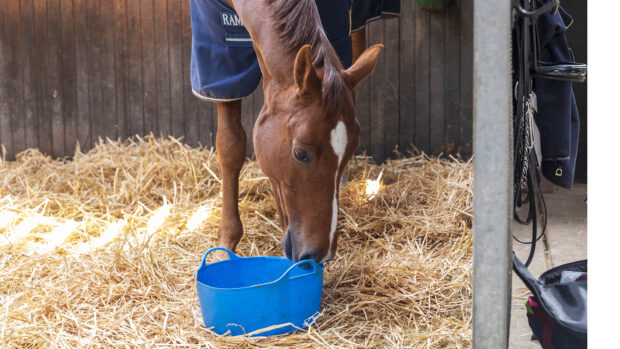Being able to undertake basic horse health checks in order to monitor your horse’s vital signs and recognise typical signs of illness early are skills that every horse owner should have. If you’re unsure of what you’re looking for or how to assess your horse, we are here to help with an easy-to-follow guide to all you need to know…
Horse health checks: Signs of illness | Temperature | Pulse | Respiration
How to take a horse’s temperature
The average healthy horse has a temperature in the range of 37–38°C or 98.5–100.5°F. An increase in temperature is typically an early sign that your horse’s health is not as it should be, so it is recommended all horses’ have regular temperature readings taken. This allows you to identify what is normal for each individual horse while doing essential horse health checks so changes can be picked up easily.
Daily monitoring of horses’ temperatures is common practice in many top competition and racing yards. It is hugely beneficial if horses can be trained to have their temperature taken as part of normal routine, just like grooming and picking out the feet.
A horse’s temperature is taken rectally normally with a digital thermometer (like this one) or occasionally an old-fashioned mercury thermometer. If the horse is unfamiliar with this procedure we recommend someone holds the horse while it takes place.
If you have a digital thermometer then turn it on. A mercury thermometer should be shaken vigorously until the mercury is below the temperature scale.
Lubricate the end of the thermometer with some petroleum jelly or a similar substance.
Standing close to the horse’s hindquarters, but to one side, lift the horse’s tail and gentle slide the thermometer into the horse’s anus until the full measuring tip of the device is inside the horse. Tilt the end of the thermometer until it is pressing gently on the gut wall, rather than being suck in the middle of a ball of droppings. NB: Make sure you have a firm hold on the device, as it has been known for the thermometer to be draw inside the rectum by some horses.
Wait a full minute for a mercury thermometer or wait for the digital version to beep, then withdraw it, wipe it clean and read the temperature. The rapid reading 10 second digital thermometer is highly recommended as it will mean less time is spent waiting in the horse’s kicking zone.
Make sure you clean and disinfect the thermometer before returning it to its case. It should be stored in a cool place.
How to take a horse’s pulse
The normal pulse rate of a horse at rest is between 28 and 42 beats per minute. This is quite a wide range so it is worth taking your own horse’s pulse at various times of day across a few days to work out what is normal for that individual. A resting horse’s pulse will rise if they are frightened, anxious, excited, have a high temperature or are in pain.
You can take a horse’s pulse where the facial artery runs over the lower jaw, by applying light pressure and counting the beats over a 15 second period. Multiple this number by four to work out the beats per minute.
Alternatively you can use the digital pulse on the horse’s leg, which is located where an artery runs over the sesamoid bones, just above the fetlock joint. Or you can place your hand on the horse’s side, just behind the elbow, where the vet would use a stethoscope to listen. It is normally more difficult to feel the pulse in these two locations.
How to measure your horse’s breathing rate
The normal respiratory rate for a horse at rest is between 8 and 16 breaths per minute. Once again, this is quite a wide window so it is worth working out what is normal for your horse.
You can count the horse’s breaths by watching the horse’s sides. They will move up and out with each breath in, then drop down and in as the horse breathes out. In cold weather you can watch the horse’s nose as you will be able to see the air being pushed out turns into vapour. Horses can only breath through their nose, so there is no risk of missing a horse taking a breath through their mouth.
Spotting typical signs of illness
Recognising the early warning signs that your horse is not feeling at their best is a skill that is acquired with experience, but there are some simple horse health checks that all owners should doing. In most cases anything that appears unusual for a particular horse should be noted and monitored as it could give useful information to a vet if a health issue develops later.
Keep an eye on your horse’s overall demeanour. If they appear quieter than usual and aren’t interacting with their field companions as normal, this could suggest a problem. Lying down or rolling more often than usual could suggest stomach pain known as colic in horses, while standing in an unusual position, such as pointing a front foot or repeatedly lifting a leg off the ground may indicate pain in that limb. However, a horse resting a hind leg while in a relaxed state is rarely significant.
If they are grumpy when being groomed, tacked up, having rugs changed or while being ridden, it is worth paying attention to. This could be early signs of a problem that hasn’t yet manifested itself into more severe clinical signs.
Changes to a horse’s levels of appetite, frequency or consistency of droppings and volume or colour of urine may be a cause for concern so we would recommend speaking to your vet in these cases. Sweating at rest, a change in breathing rate, and a raised pulse can all be signs of pain.
While a small trickle of clear discharge from a horse’s nose is unlikely to be a cause for concern, thick or coloured mucus suggests a problem. Any consistent discharge from the eyes is unusual and warrants veterinary investigation.
Any heat or swelling on a limb, especially accompanied by lameness, is a clear sign there is a problem. Even minor cuts and grazes should be attended to promptly to help avoid infection setting in.
If you are concerned about your horse, then it is wise to check their temperature, pulse and respiration against their normal levels and have this information to hand when you contact your vet. It helps to keep a temperature chart, especially if you are travelling with your horse. Your vet will appreciate having the information available, if required.
You may also be interested in…

Equine first-aid kit essentials: what you really need
If you're unsure about what you should have in your horse’s first-aid kit, then we are here to help...

Horse & Hound’s definitive guide to equine vaccinations

Horse & Hound’s essential guide to worms and deworming

Lameness in horses: what every owner needs to know





